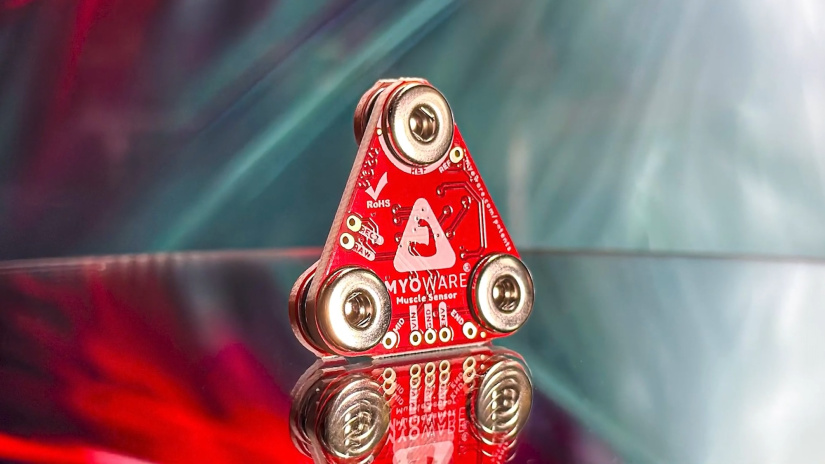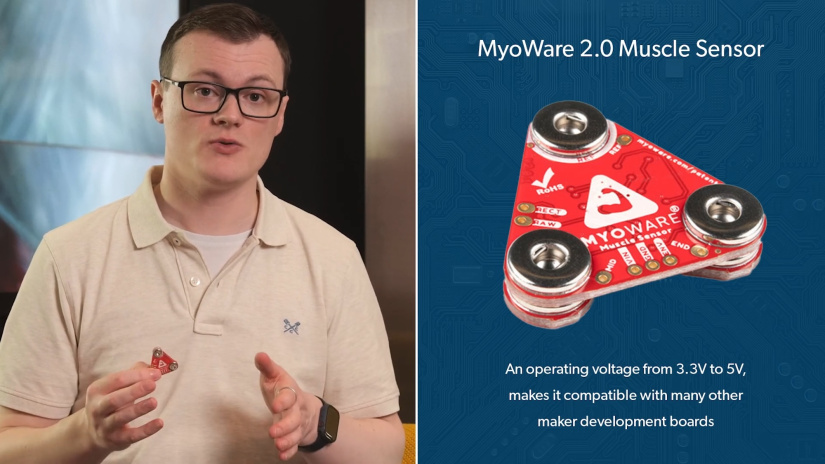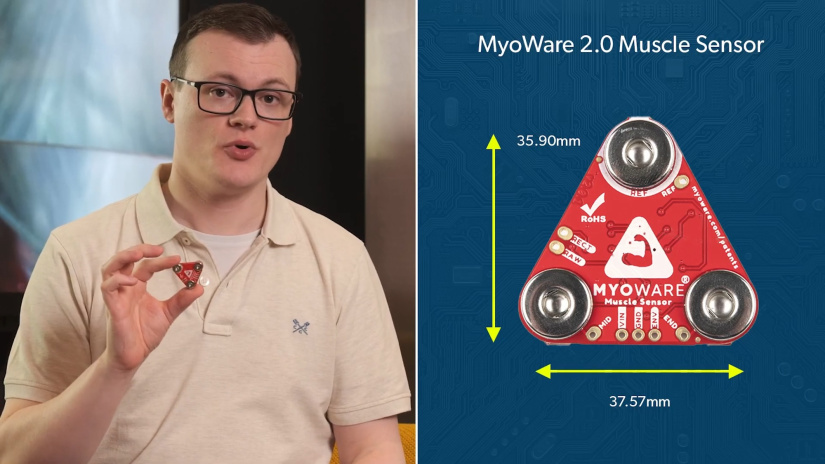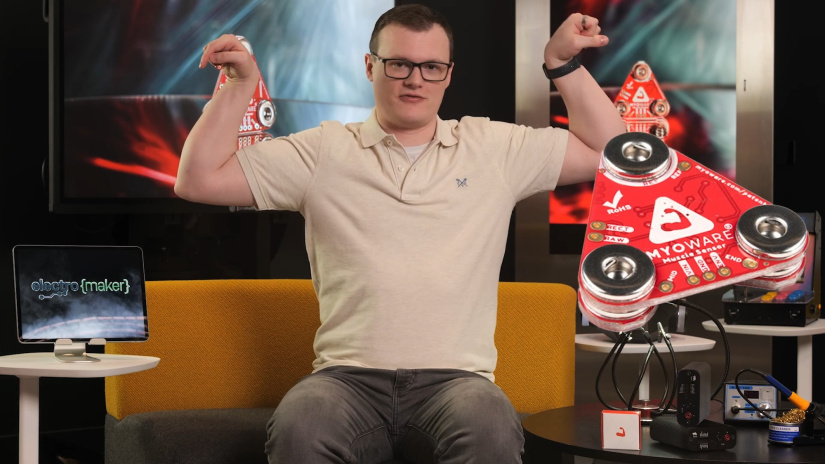Product of the Week: MyoWare 2.0 Muscle Sensor for Advanced Robotics Control
Welcome to this week's featured product! Today, we are diving into the world of muscle sensing technology with the MyoWare 2.0 Muscle Sensor. This innovative sensor is designed to measure muscle activity, making it an invaluable tool for a variety of applications, including robotics, prosthetics, and fitness monitoring.
Overview of MyoWare 2.0 Muscle Sensor
The MyoWare 2.0 Muscle Sensor is a cutting-edge device that measures muscle activity through surface electromyography (EMG). This sensor is designed to detect muscle tension by reading the electrical potential generated by muscle fibers during contraction.
Using adhesive electrodes, the MyoWare 2.0 can be easily attached to various muscle groups on the body. These sticky electrodes allow for a secure and comfortable fit, eliminating the need for cumbersome belts or fixtures. This makes it incredibly convenient for users to place the sensor precisely where muscle activity needs to be monitored.
The simplicity and effectiveness of the MyoWare 2.0 Muscle Sensor open up a world of possibilities for makers and developers. Its ability to seamlessly attach to the skin and provide accurate muscle activity readings makes it an essential tool for innovative projects in robotics, prosthetics, and more.

MyoWare 2.0 - Features and Benefits
The MyoWare 2.0 Muscle Sensor is packed with features that make it a versatile and powerful tool for measuring muscle activity. Here’s a detailed look at its key features and the benefits they offer:
- Snap Connectors: The sensor is equipped with snap connectors that allow for easy attachment of additional wires. This feature enables users to measure muscle activity from multiple points, providing more comprehensive data.
- Multiple Test Points and Contacts: The sensor includes various test points and contacts, allowing developers to access different signals directly. This flexibility is crucial for advanced projects requiring precise signal monitoring.
- Adjustable Onboard Circuitry: The MyoWare 2.0 Muscle Sensor features adjustable onboard circuitry. This allows users to calibrate the sensor for different muscle strengths, ensuring accurate readings regardless of the user's physical condition.
- Analog Output Signal: The sensor outputs an analog voltage signal ranging from 0 volts to the supply voltage. This signal corresponds to the muscle's electrical activity, making it easy to interface with various devices and systems.
- Compact Size: The small and lightweight design of the MyoWare 2.0 Muscle Sensor makes it easy to integrate into a wide range of projects. Its compact size ensures it can be discreetly attached without hindering the user's movements.
- Compatibility: The sensor is compatible with numerous development boards, including Arduino and Raspberry Pi. This broad compatibility makes it an ideal choice for both beginners and experienced developers working on different platforms.

These features collectively make the MyoWare 2.0 Muscle Sensor a highly versatile and effective tool for a wide range of applications, from simple fitness monitoring to complex robotics and prosthetic projects.
MyoWare 2.0 - Technical Specifications
The MyoWare 2.0 Muscle Sensor comes with a robust set of technical specifications designed to ensure reliable and versatile performance. Here are the key technical details:
- Operating Voltage Range: The sensor operates within a voltage range of 3.3V to 5V, making it compatible with a variety of development boards and power supplies.
- Output Modes: The sensor supports three different output modes: Raw EMG, Rectified, and Envelope. These modes provide flexibility in how the muscle activity data is processed and utilized.
- Snap-On Protective Cover: To protect the delicate circuitry, the MyoWare 2.0 Muscle Sensor includes a snap-on protective cover. This cover helps prevent damage during use and handling.
- Reverse Polarity Protection: The sensor is equipped with reverse polarity protection, safeguarding it against damage from incorrect power supply connections.
- LED Indicators: The sensor features LED indicators for voltage and envelope signals. These LEDs provide visual feedback on the sensor’s status and signal strength, aiding in setup and troubleshooting.

These technical specifications highlight the MyoWare 2.0 Muscle Sensor's capability to deliver precise and reliable muscle activity data across various applications.
MyoWare 2.0 - Practical Applications
The MyoWare 2.0 Muscle Sensor opens up a myriad of practical applications across various fields. Here are some notable examples:
Fitness Monitoring Device
The MyoWare 2.0 Muscle Sensor can be utilized to measure muscle effort during exercise routines. By attaching the sensor to different muscle groups, users can monitor the intensity and effectiveness of their workouts.
Example Project: Use the sensor to monitor leg muscle activity during workouts. Attach the sensor to the quadriceps or hamstrings to track muscle engagement and effort during exercises like squats or lunges.

Game Controller
Integrating the MyoWare 2.0 Muscle Sensor into AR/VR setups can enhance player interactions by using muscle activity as an input method. This provides a more immersive and intuitive gaming experience.
Example Project: Use the sensor to control movements in a VR environment. By detecting muscle activity in the arms or legs, players can interact with virtual objects and navigate the virtual space more naturally.
Accessibility Solutions
The MyoWare 2.0 Muscle Sensor can significantly improve accessibility for individuals with physical disabilities. By converting small muscle movements into control signals, it allows users to interact with everyday devices that might otherwise be difficult to use.
Example Project: Develop an interface that uses the sensor to control a computer or smart device. Small muscle movements can be translated into cursor movements or command inputs, enabling users with limited mobility to operate the device efficiently.

How to Get Started
Setting up the MyoWare 2.0 Muscle Sensor is straightforward. Follow this step-by-step guide to get started with measuring muscle activity in your projects.
Step 1: Attaching the Sensor Pads
Begin by attaching the adhesive sensor pads to the MyoWare 2.0 Muscle Sensor. Ensure that the pads are securely connected to the snap connectors on the sensor.
Next, place the sensor pads on the muscle group you wish to monitor. For best results, position the pads along the length of the muscle, ensuring they are firmly attached to the skin.
Step 2: Connecting the Sensor to a Microcontroller
Once the sensor pads are in place, connect the MyoWare 2.0 Muscle Sensor to your chosen microcontroller. You can use jumper wires to connect the sensor’s output to an analog input pin on the microcontroller.
Here is an example connection setup for an Arduino board:
Signal (SIG) pin on MyoWare -> A0 pin on Arduino
Vcc pin on MyoWare -> 3.3V or 5V pin on Arduino
GND pin on MyoWare -> GND pin on Arduino
Step 3: Example Code Snippets for Initial Testing
After connecting the sensor, upload the following example code to your Arduino to start reading muscle activity data:
const int sensorPin = A0;
int sensorValue = 0;
void setup() {
Serial.begin(9600);
}
void loop() {
sensorValue = analogRead(sensorPin);
Serial.println(sensorValue);
delay(100);
}
This code reads the analog signal from the MyoWare 2.0 Muscle Sensor and prints the values to the serial monitor. You can use these readings to gauge muscle activity and further refine your project.
With these initial steps, you're ready to explore the full potential of the MyoWare 2.0 Muscle Sensor in your innovative projects.

Final Thoughts
The MyoWare 2.0 Muscle Sensor is a versatile and powerful tool that offers a wide range of applications in measuring muscle activity. From fitness monitoring and game controllers to advanced robotics and prosthetics, this sensor provides accurate and reliable data that can enhance your projects.
Ready to get started? Visit the Electromaker store to purchase the MyoWare 2.0 Muscle Sensor and other components you need for your next project. Unlock the power of muscle sensing and take your creations to the next level!
Did you enjoy this review? Make sure you subscribe to The Electromaker Show for similar content!














































Leave your feedback...